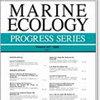Forecasted changes to the timing of Pacific herring Clupea pallasii spawn in a warming ocean
IF 2.1
3区 环境科学与生态学
Q2 ECOLOGY
引用次数: 0
Abstract
ABSTRACT: Pacific herring Clupea pallasii are a critical commercial and subsistence fish species and play a keystone role in the ecology and culture of the North Pacific. The annual herring spawn, in which mature herring migrate nearshore to deposit eggs along the coastline, is an important event linked to the migration of seabirds and marine mammals as well as a subsistence harvest for Alaska Natives and First Nations in British Columbia. Previous work has suggested that environmental variables and broad teleconnection indices play a role in the magnitude and phenology of spawning; however, the effects of these drivers have not been examined in the context of future climate scenarios. Here, we modeled variability in the timing of herring spawn across British Columbia and Southeast Alaska using survey data from 1951-2022. We created a model using Pacific teleconnection indices, sea surface temperature (SST), tidal height, and lagged data to predict spawn date anomalies (SDAs) across 9 spawning regions. SDAs were significantly affected by the Oceanic Niño Index, Pacific Decadal Oscillation, SST, and lagged SDAs. We then used this model to predict SDAs using projected SST from climate models and bootstrapped teleconnection data from 2025-2100. Future herring spawn timing trends earlier on average with warming SSTs, although the magnitude is relatively small, occurring 9 d earlier on average by 2100. This changing phenology, though small, varied by region and may have ecosystem-level ramifications and create timing mismatch for migratory species. However, our findings also reinforce the importance of other physical factors not measured in this study, such as photoperiod, which drive herring spawn timing.预测变暖海洋中太平洋鲱鱼(Clupea pallasii)产卵时间的变化
摘要:太平洋鲱鱼(Clupea pallasii)是一种重要的商业和生计鱼类,在北太平洋的生态和文化中发挥着关键作用。每年鲱鱼产卵时,成熟的鲱鱼会洄游到近岸,在海岸线上产卵,这是一个与海鸟和海洋哺乳动物的洄游有关的重要事件,也是阿拉斯加土著和不列颠哥伦比亚省原住民的生计收获。以往的研究表明,环境变量和广泛的远缘指数对产卵的规模和物候起着一定的作用;然而,这些驱动因素的影响尚未在未来气候情景下进行研究。在此,我们利用 1951-2022 年的调查数据,模拟了不列颠哥伦比亚省和阿拉斯加东南部鲱鱼产卵时间的变化。我们利用太平洋遥联指数、海面温度(SST)、潮汐高度和滞后数据创建了一个模型,以预测 9 个产卵区域的产卵日期异常(SDAs)。产卵期异常受海洋尼诺指数、太平洋十年涛动、海面温度和滞后产卵期异常的影响很大。然后,我们使用该模型,利用气候模型预测的 SST 和 2025-2100 年的引导远缘数据预测 SDA。随着海温的升高,未来鲱鱼产卵时间平均会提前,但幅度相对较小,到 2100 年平均提前 9 d。这种物候变化虽然幅度较小,但因地区而异,可能会对生态系统产生影响,并造成洄游物种的时间错配。不过,我们的研究结果也加强了本研究未测量的其他物理因素(如光周期)的重要性,这些因素驱动着鲱鱼的产卵时间。
本文章由计算机程序翻译,如有差异,请以英文原文为准。
求助全文
约1分钟内获得全文
求助全文
来源期刊

Marine Ecology Progress Series
环境科学-海洋学
CiteScore
5.30
自引率
8.00%
发文量
238
审稿时长
3 months
期刊介绍:
The leading journal in its field, MEPS covers all aspects of marine ecology, fundamental and applied. Topics covered include microbiology, botany, zoology, ecosystem research, biological oceanography, ecological aspects of fisheries and aquaculture, pollution, environmental protection, conservation, and resource management.
 求助内容:
求助内容: 应助结果提醒方式:
应助结果提醒方式:


